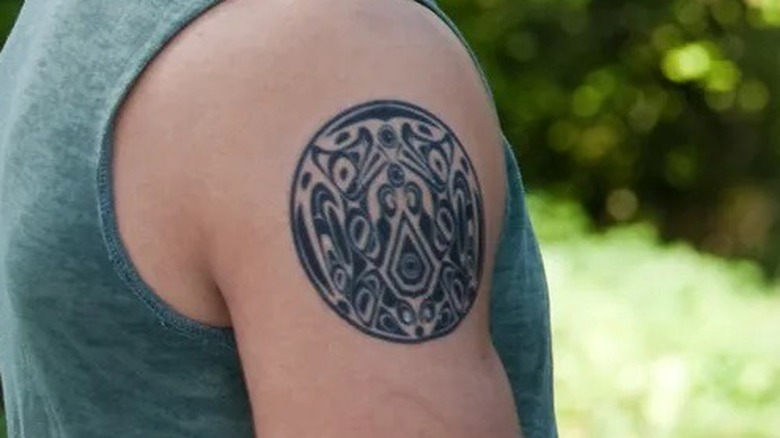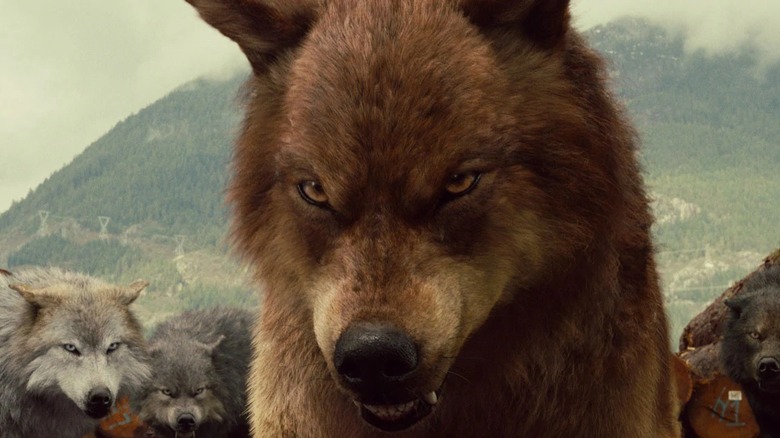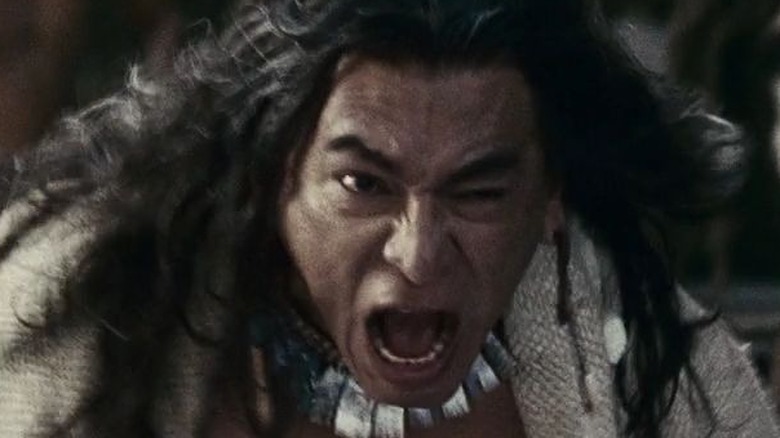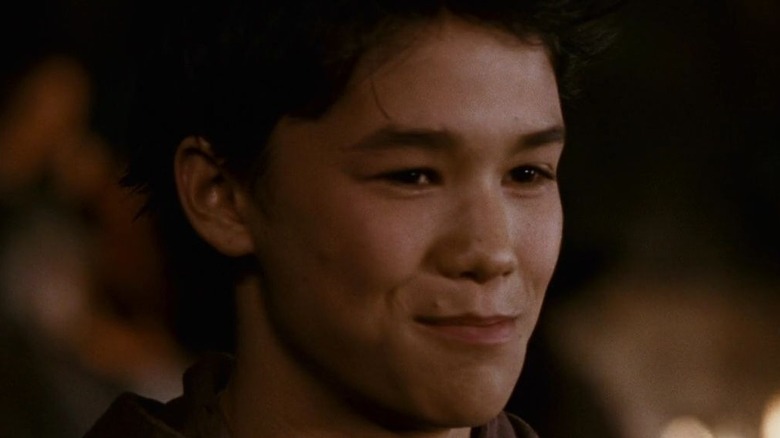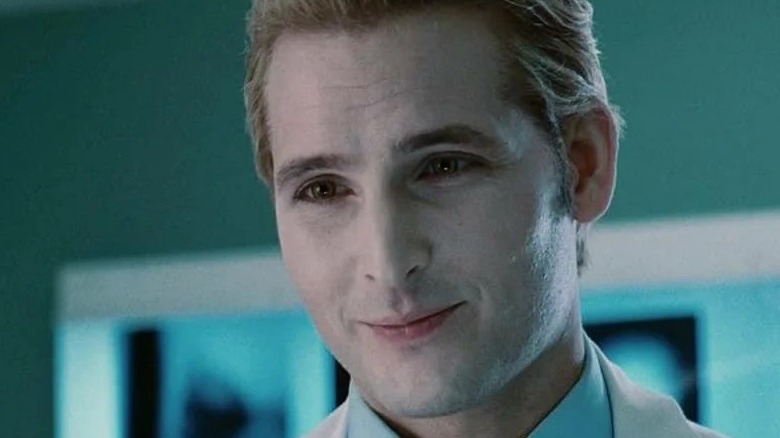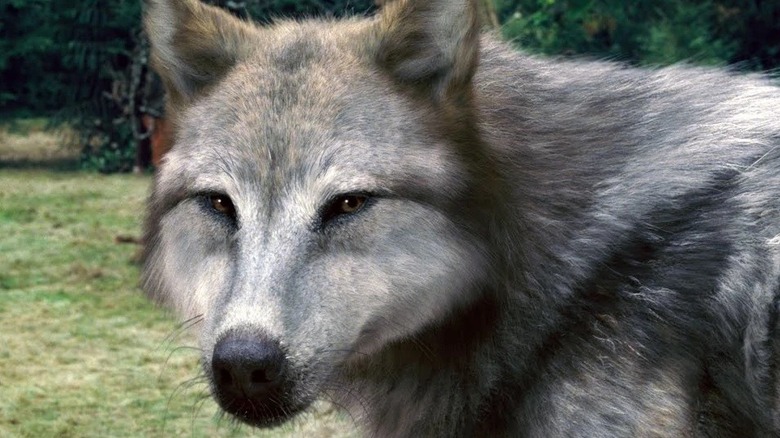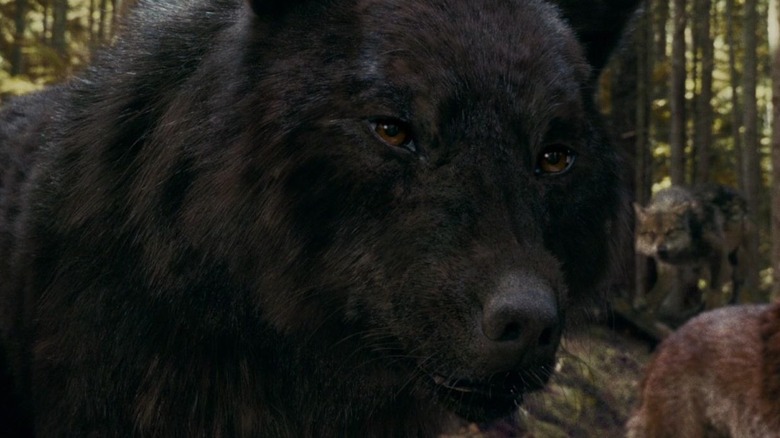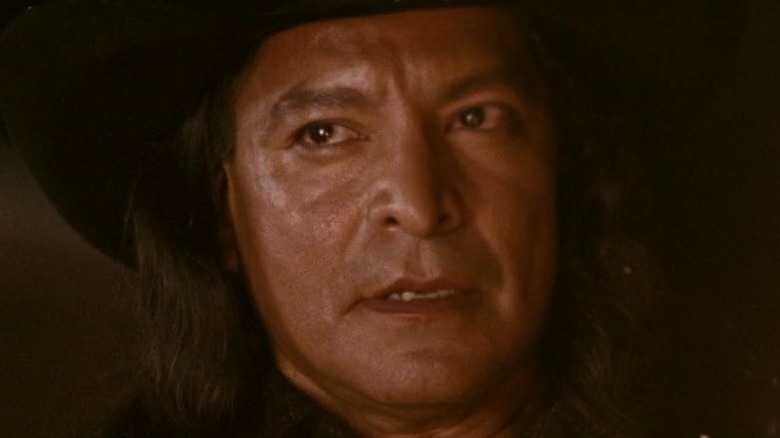The Untold Truth Of Twilight's Quileute Tribe
"Twilight" fans probably recognize the word "Quileute" when they see it. The Native American tribe in La Push (a town near Forks, Washington) plays a major role in the series, with some members transforming into wolves. Jacob Black, one third of the Edward-Bella-Jacob love triangle, is a member of the tribe and its wolf pack.
The Quileute Tribe has a rich history in Forks, both in universe and out. In the series, they protect the people of Forks from rogue vampires, though sometimes what they define as a "rogue" vampire is different from how the Cullens would use the definition (mostly because all vampires are rogue to the Quileute). The tribe is home to the second supernatural species of the series, which may not actually be as supernatural as audiences think it is.
While author Stephenie Meyer reveals quite a bit about the tribe and the pack during the series, there's plenty more information about their abilities, history, and hierarchy in supplemental materials. Do you want to learn more about how the pack functions, who can become a member, and why they started shape-shifting in the first place? Bundle up by the campfire — it gets cold in La Push — as we share all the secrets you never knew about the Quileute Tribe from "Twilight."
The Quiluete are a real Native American tribe in the Pacific Northwest
The Quileute people are not an invention of Stephenie Meyer; they are a real Native American nation in La Push, Washington. In conjunction with the Burke Museum in Seattle, the tribe has worked to correct misconceptions the series started about them. While the Quileute people have stories involving wolves, they are in no way rooted in a quest to fight against vampires. According to the museum's "Truth versus Twilight" page, the tribe's actual origin story is that "Qwati transforms the first Quileute people from wolves."
The tribe has received no direct monetary compensation for the use of its name in the books or the films. It has also received no percentage of profits from merchandise utilizing the "Quileute" tattoo created for the film. The Burke Museum argues that this "does exemplify abuses of cultural appropriation" because it has become synonymous with a tribe that had no say in its creation. Also, the style the designer of the tattoo used is a Native style belonging to the Haida, a tribe from British Columbia. "The tattoo not only takes from Quileute oral traditions, but also does a disservice to all Northwest Coast tribes as it confuses and alters their rich and varied visual culture."
Fans of the "Twilight" series who are planning to visit the area should be sure to check out the Quileute etiquette page, which advises visitors on the dos and don'ts of visiting the land.
They aren't actually werewolves
The Quileute characters can turn into wolves, but they're not actually werewolves, despite being called that throughout the series. In what is arguably the most overlooked part of "Breaking Dawn," during the almost-battle between the Cullens, their witnesses, and the vampire governing body the Volturi, it's revealed that "werewolf" was never the correct term to describe them.
Werewolves, also called Children of the Moon in the franchise, can't control their transformations, which are dependent on the phases of the moon. According to "The Official Illustrated Guide," werewolves in the "Twilight" universe still have hands while in their wolf form, opposable thumbs and all. Meyer also describes their stance as "more upright, making their movement somewhat apelike, rather than entirely canine." This is not at all how the Quileute shape-shifters are depicted, both in the books and films.
Caius, one of the ruling members of the Volturi, wants to have the pack eliminated, believing them to be Children of the Moon — vampires have worked to eradicate the species for many years. Edward Cullen informs the ruling party that it is daylight and the wolves are transformed, which would automatically rule them out as true werewolves. Aro, another Volturi leader, agrees. When Caius tries to have them killed on the basis they know of vampires, he's reminded that the wolves are also supernatural, so there is no harm in them knowing of another supernatural species.
How they became shape-shifters
Because the members of the pack are not true werewolves, it means they weren't bitten by one to enable their transformations. So how did the Quileute Tribe become shape-shifters? "The Official Illustrated Guide" details that it all goes back to the early people of the tribe. They could have out-of-body experiences on the astral plane, also known as being able to astral project. In projecting, someone can travel to other places, sometimes even other planets or spaces.
At one point in the tribe's history, their ability to do this caused a coup within the tribe over who should be the chief. Meyer doesn't go into the specifics, like who was staging it, but the illustrated guide does detail that it happened sometime between 1230 and 1250. During the coup, the rightful chief placed his spirit into a wolf's body. From this point forward, his offspring could take the form of a wolf. This chief's name was Taha Aki, and he was the first shape-shifter of the Quileute Tribe.
This ability came about before the tribe's knowledge of vampires. When the first vampires entered their territory, long before their treaty with the Cullens, the tribe figured out they could take on the vampires in their wolf forms. They weren't more powerful than them, but they could hold their own. This newfound knowledge gave them a purpose and actually made it so that their transformations only came if vampires were around.
Who becomes a shape-shifter?
Anyone in the tribe that can transform into a wolf can trace their ancestry back to Taha Aki. Based on the timeline provided in "The Official Illustrated Guide," the first time one of the chief's ancestors shifted was in 1265. Since then, anyone who can trace their tribal lineage back to Aki should have the ability to transform if the conditions are right. It isn't only males either — after Leah Clearwater goes through the transformation in "Eclipse," the tribe realizes that female descendants can also become part of the pack.
Being related to the first chief that shifted means your DNA is different. Those that can transform into a wolf actually have an extra set of chromosomes compared to what humans normally have, based on Meyer's writing in "The Official Illustrated Guide." A typical non-supernatural human has 23 pairs of chromosomes, whereas a descendant of Aki has 24 pairs. The only thing this extra pair seems to do is allow them to take on the same form as their ancestors.
The treaty with the Cullens
Though the Quileute Tribe was introduced to vampires many years before, it wasn't until 1936 that a treaty with the Cullens became a reality. They had become accustomed to dealing with the occasional vampire, but the Cullens came as a coven of five: Carlisle, Esme, Edward, Emmett, and Rosalie. The wolves also noticed these "cold ones" had golden eyes, rather than the red ones they'd seen in others.
It was Carlisle who spoke to them, telling the tribe that he and his family had no intention of hurting them or any humans in the area. He shared their "vegetarian" lifestyle with them. The doctor asked for some kind of treaty between the two parties so the Cullens could live in the area. At the time, the Quileute pack only had three wolves, so they were in no position to take the vampires on.
The Alpha at the time, Jacob's ancestor Ephraim Black, thought Carlisle's offer was genuine simply because they could've easily killed the wolves with their numbers. Ephraim agreed to a treaty, so long as the vampires didn't come on their land and didn't hurt any humans. This included turning a human, as the pack considered it murder, according to "The Official Illustrated Guide." The Cullens agreed, so long as each species would keep the other's existence a secret. Even though the vampires moved away for a time, the treaty was still honored when they returned.
Pack hierarchy can get complicated
Like most wolf packs, the Quileute wolves have an Alpha. Everyone listens to the Alpha and obeys their orders. This position is typically lineage based, though that isn't always the case. Ephraim was the Alpha of his pack in the 1930s, which should mean that Jacob is an Alpha. However, Sam Uley was the first to shift, so he became the de facto Alpha because he had experienced life as a wolf the longest. This set-up is later questioned by Jacob, who decides to become the Alpha he was always meant to be and start his own pack. This means that at one point there were two packs among the tribe.
In addition to Alphas, "The Official Illustrated Guide" describes who takes over if an Alpha is killed. The next in command is the Second, who will become the new Alpha if something happens. Behind the Second is the Third, who would then move forward in the hierarchy. In large packs, the Second may have their own Second and Third, as would the Alpha's Third. This ensures there is always someone to move into a position and prevents confusion within the pack.
Only those in the tribe that can shift are considered members of the pack. Most of the tribe outside of the council of elders are not familiar with the wolves. While the tribe's council is familiar with their condition, they are not considered members of the pack.
Their transformations are controlled by their emotions
The first transformation is the hardest. After going through a growth spurt and fever, the individual will start to have mood swings, according to "The Official Illustrated Guide." This includes "brief, sudden episodes of nearly uncontrollable rage." During one of these episodes, they may begin to shake, which means the first phase is on the horizon. If they can't control their anger at this moment, they'll transform.
After understanding what they've become, the new wolf has to learn to control their emotions. If they lose that control, they will shift in an instant. As members of the pack become more familiar with their new abilities, they will be able to transition on their terms, meaning they can change out of their clothes before they phase. If they shift while dressed, their clothes rip into shreds, meaning they won't have anything to put on when they take their human form again. Most wolves have a leather strap that they use to tie their clothes to their leg while transformed, ensuring they have something to wear when they shift back. A little forward thinking can go a long way.
They have limited immortality after the shift
As part of their transition, the wolves have limited immortality. When they shift, their growth speeds up, helping them reach their final body size much faster than they would normally. After this point, the individual remains fixed around the age of 25, based on the information Meyer provided in "The Official Illustrated Guide." They will stay frozen at that age for as long as they continue to phase into a wolf, much like their cold enemies that are forever the age they were when they were turned into a vampire.
A member of the Quileute pack could stay like this forever, enjoying their youth, protecting the tribe and locals from vampires, and being there to pass down the legends to the next generations. However, many choose to give up the ability to transform so they can age and not outlive their friends and family. Once that decision is made, their aging will return, eventually going back to the standard pace experienced by humans.
Like vampires, they experience some other perks along with their immorality. Wolves can heal much faster than humans, with broken bones healing in a matter of days rather than weeks. "The Official Illustrated Guide" notes that they "are not indestructible" but confirms that "it still takes supernatural strength or great skill to seriously wound" one of the wolves. Members of the pack also have a heightened sense of smell, better sight, and incredible speed.
The pack always knows what you're thinking
One of the pack's abilities that is unique to them is their telepathic communication. Unlike Edward's one-sided telepathy, when they're transformed, they can all communicate through their minds, reading each other's thoughts and feeling each other's emotions. It's referred to in "The Official Illustrated Guide" as a "group mind." This ability allows them to work together as a team, but it can also be pretty painful for some members at times. In the group mind, there is no way to hide from your pack. If you shift because you're angry, they will see what made you angry. If you're uncomfortable with the Alpha's decision, they'll know.
When Jacob creates his own pack in "Breaking Dawn," he is cut off from the group mind. When Leah and her brother Seth come to join Jacob, thus making a new pack, they all share a group mind but can't access the original one. Meyer shared in "The Official Illustrated Guide" that the Alpha of each pack has the option of sharing their thoughts with the others, even having the ability to pick and choose which thoughts to send.
Some wolf abilities extend to their human forms
Some of the things that help pack members in wolf form also extend to when they aren't transformed. For example, their ability to heal quickly works well when they're human. Jacob is injured in wolf form, able to shift back and have his broken bones set by Carlisle, and still heals quickly considering a whole side of his body was crushed. In these instances, it's better to be human so they heal correctly. As humans, they are also faster and stronger than they were previously, but not to the same extent they are as wolves.
The group mind does not work when in human form. When Jacob finds out Bella and Edward are getting married at the end of "Eclipse," he shifts because of his emotions and asks the rest of the pack not to follow him. He doesn't want them to read his mind, but he's too upset to be able to shift back at that moment. They also can't kill vampires as humans, which should come as no surprise.
Imprinting isn't what you think it is
According to "The Official Illustrated Guide," imprinting is "a bonding incident" in which a member of the pack becomes "unconditionally tied to a human of the opposite sex." The tribe isn't quite sure of the reason behind this. Some believe it's to ensure only the best wolves are created in the next generation, while others think it's just to ensure the species survives at all. An individual has to have gone through the transformation in order to imprint. After the shift, they can imprint at any given time — it's not something they control. The moment they see the individual they are meant to imprint with, it just happens.
Once a tribe member has imprinted, their life is never the same. They take on whatever role they need to for the imprintee. And, while it's often the case, this isn't necessarily a romantic union. When Jacob imprints on Bella and Edward's baby (a moment that some fans think went too far), he becomes a protector to her. Once someone has imprinted, the person they imprint on is protected both by and from the tribe: It is against the laws of the pack to hurt an individual a wolf has imprinted on. This is the reason the wolves do not kill the conspicuously CGI baby Renesmee, who they believe violates the treaty as a hybrid.
Their ancestry doesn't guarantee they become a wolf
Even if a Quileute Tribe member can trace their ancestry back to Taha Aki, there is still no guarantee that they will transform. There has to be the right melting pot of conditions for someone's extra pair of chromosomes to activate and enable them to shift. It has to be after the onset of puberty, but before the age of 25, based on Meyer's writing in "The Official Illustrated Guide." There also needs to be a need for the wolves. When the Cullens moved back to Forks in 2003, there was suddenly a need for wolves again.
The first time someone becomes a wolf, the transformation seems to take about a week. When Embry first turns, he is out of school for a week in "New Moon," which gives readers a pretty good benchmark. Sometimes it takes longer. When Sam transforms, it takes him two weeks to regain his composure and become human again. However, this is partly because he is the first to phase after the return of the Cullens, so there's nobody to help him through the process.
If there are no vampires, transformation never comes. The pack led by Ephraim was the last one until Sam turned. The likes of Jacob's dad never transformed because there wasn't a reason to.

